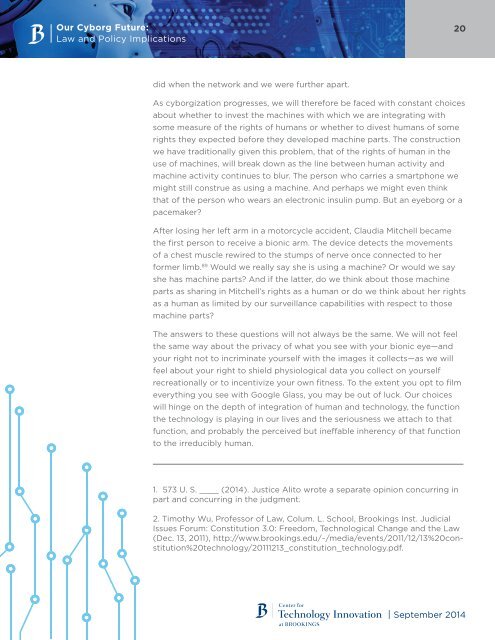cyborg_future_law_policy_implications_FINAL2
cyborg_future_law_policy_implications_FINAL2
cyborg_future_law_policy_implications_FINAL2
Create successful ePaper yourself
Turn your PDF publications into a flip-book with our unique Google optimized e-Paper software.
Our Cyborg Future:Law and Policy Implications20did when the network and we were further apart.As <strong>cyborg</strong>ization progresses, we will therefore be faced with constant choicesabout whether to invest the machines with which we are integrating withsome measure of the rights of humans or whether to divest humans of somerights they expected before they developed machine parts. The constructionwe have traditionally given this problem, that of the rights of human in theuse of machines, will break down as the line between human activity andmachine activity continues to blur. The person who carries a smartphone wemight still construe as using a machine. And perhaps we might even thinkthat of the person who wears an electronic insulin pump. But an eyeborg or apacemaker?After losing her left arm in a motorcycle accident, Claudia Mitchell becamethe first person to receive a bionic arm. The device detects the movementsof a chest muscle rewired to the stumps of nerve once connected to herformer limb. 89 Would we really say she is using a machine? Or would we sayshe has machine parts? And if the latter, do we think about those machineparts as sharing in Mitchell’s rights as a human or do we think about her rightsas a human as limited by our surveillance capabilities with respect to thosemachine parts?The answers to these questions will not always be the same. We will not feelthe same way about the privacy of what you see with your bionic eye—andyour right not to incriminate yourself with the images it collects—as we willfeel about your right to shield physiological data you collect on yourselfrecreationally or to incentivize your own fitness. To the extent you opt to filmeverything you see with Google Glass, you may be out of luck. Our choiceswill hinge on the depth of integration of human and technology, the functionthe technology is playing in our lives and the seriousness we attach to thatfunction, and probably the perceived but ineffable inherency of that functionto the irreducibly human.1. 573 U. S. ____ (2014). Justice Alito wrote a separate opinion concurring inpart and concurring in the judgment.2. Timothy Wu, Professor of Law, Colum. L. School, Brookings Inst. JudicialIssues Forum: Constitution 3.0: Freedom, Technological Change and the Law(Dec. 13, 2011), http://www.brookings.edu/~/media/events/2011/12/13%20constitution%20technology/20111213_constitution_technology.pdf.| September 2014


